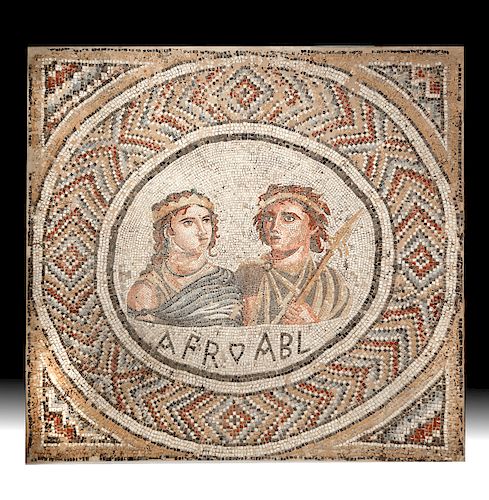Large Roman Stone Mosaic - Regal Couple w/ Initials
Lot 69
About Seller
Artemis Fine Arts
686 S Taylor Ave, Ste 106
Louisville, CO 80027
United States
Selling antiquities, ancient and ethnographic art online since 1993, Artemis Gallery specializes in Classical Antiquities (Egyptian, Greek, Roman, Near Eastern), Asian, Pre-Columbian, African / Tribal / Oceanographic art. Our extensive inventory includes pottery, stone, metal, wood, glass and textil...Read more
Estimate:
$40,000 - $60,000
Absentee vs Live bid
Two ways to bid:
- Leave a max absentee bid and the platform will bid on your behalf up to your maximum bid during the live auction.
- Bid live during the auction and your bids will be submitted real-time to the auctioneer.
Bid Increments
| Price | Bid Increment |
|---|---|
| $0 | $25 |
| $300 | $50 |
| $1,000 | $100 |
| $2,000 | $250 |
| $5,000 | $500 |
| $10,000 | $1,000 |
| $20,000 | $2,500 |
| $50,000 | $5,000 |
| $100,000 | $10,000 |
| $200,000 | $20,000 |
About Auction
By Artemis Fine Arts
Sep 26, 2019
Set Reminder
2019-09-26 10:00:00
2019-09-26 10:00:00
America/New_York
Bidsquare
Bidsquare : Exceptional Day 1: Antiquities & Asian Art
https://www.bidsquare.com/auctions/artemis-gallery/exceptional-day-1-antiquities-asian-art-4437
Day 1 of an important 2-day auction featuring exceptional, museum-worthy examples of Egyptian, Greek, Etruscan, Roman, Viking, Russian, Near Eastern, as well as Asian Art from China, Japan, Thailand, Vietnam, Burma and India. Artemis Fine Arts info@artemisfinearts.com
Day 1 of an important 2-day auction featuring exceptional, museum-worthy examples of Egyptian, Greek, Etruscan, Roman, Viking, Russian, Near Eastern, as well as Asian Art from China, Japan, Thailand, Vietnam, Burma and India. Artemis Fine Arts info@artemisfinearts.com
- Lot Description
Roman, the Levant, late Imperial Period, ca. 3rd to 4th century CE. An impressive and quite sizeable mosaic comprised of thousands of square stone tesserae depicting a couple in a roundel with initials beneath each portrait - "AFR" beneath the female and "ABL" beneath the male. Between these initials is a symbol that resembles a heart. Of course, the heart as a symbol of romantic love was not used until the Middle Ages; in this case, it may have represented a fruit or leaf. Both the male and the female are meticulously delineated with naturalistic features and exceptional modeling so as to provide a sense of three dimensionality and life. They are depicted in 3/4 view and gaze at one another with dreamy hazel eyes. Both are finely dressed in flowing garments and golden crowns. The female is also bedecked with a green stone necklace, earrings, and a crown jewel. The man grips his pointed spear, and a handsome fibula secures the drapery folds of his toga. All is delineated in tesserae of various shades of red, grey, umber, peach, cream, taupe, rose, and yellow. Size: 61.375" W x 57.625" H (155.9 cm x 146.4 cm)
The 3/4 portraits are set against a creamy white ground. Concentric bands of taupe and white tesserae surround this figurative roundel. Next is a wide band with 4 diamonds set at the cardinal points and nested chevrons between them. This is followed by additional narrow bands and corners presenting zigzag motifs.
Mosaics (opus tesellatum) are some of our most enduring images from the Roman world, exciting not only for their aesthetic beauty, but also because they reveal what Romans chose to depict and see every day decorating their private and public spaces. Popular ancient Roman mosaic themes were often mythological or religious scenes, depicting gods and goddesses; however, sometimes mosaics were created to fit the theme of a building or room. This mosaic may have been intended for a public space within a Roman villa such as an atrium, a vestibulum, or a triclinium - to remind the visitors of their hosts' beauty, wealth, and status.
Provenance:private East Coast, USA collection; ex-Long Island, New York, USA private collection, 1980s
All items legal to buy/sell under U.S. Statute covering cultural patrimony Code 2600, CHAPTER 14, and are guaranteed to be as described or your money back.
A Certificate of Authenticity will accompany all winning bids.
We ship worldwide and handle all shipping in-house for your convenience.
#146425All the stone tesserae are ancient. They are set in a modern matrix and metal frame. Some expected chips to tesserae and some missing tesserae as shown; however, the majority of the composition has survived. Some stable fissures to the matrix. Scattered mineral deposits grace the surface.Condition
- Shipping Info
-
All shipping is handled in-house for your convenience. Your invoice from Artemis Gallery will include shipping calculation instructions. If in doubt, please inquire BEFORE bidding for estimated shipping costs for individual items.
-
- Buyer's Premium



 EUR
EUR CAD
CAD AUD
AUD GBP
GBP MXN
MXN HKD
HKD CNY
CNY MYR
MYR SEK
SEK SGD
SGD CHF
CHF THB
THB















